Wisteria Vine & Tree: How to Plant, Grow & Care

What is Wisteria?
The Wisteria Tree, more commonly known as the Wisteria vine, is a flowering plant known for its stunning and fragrant cascading flower clusters. It’s part of the Fabaceae (pea/bean) family. The botanical name for the most common species is Wisteria sinensis.
Wisteria can be trained to grow as a tree or shrub, but it is naturally a vine. It’s a fast-growing plant that can reach heights of up to 60 feet as a vine or 15-25 feet when trained as a tree. The plant produces flowers in late spring to early summer that are typically purple, blue, or white.
It’s native to parts of China, Japan, and the eastern United States. Wisteria prefers full sun to partial shade and well-drained, moist, fertile soil. It requires regular pruning to control growth and promote blooming.
Despite its beauty, gardeners should be cautious as Wisteria can be invasive if not properly managed. It’s also important to note that all parts of the plant are poisonous if ingested.
Fast Facts About Wisteria
| Feature | Details |
|---|---|
| Common Name | Wisteria |
| Botanical Name | Wisteria sinensis |
| Family | Fabaceae |
| Plant Type | Deciduous vine (often trained as a tree) |
| Genus | Wisteria |
| Mature Height | Trained as a tree, it can grow up to 15-25 feet tall. As a vine, it can climb up to 60 feet or more. |
| Mature Width | Can spread up to 10-30 feet wide depending on the support structure and pruning. |
| Sun Exposure | Full sun to partial shade |
| Soil Type | Well-drained, moist, fertile soil |
| Soil pH | Prefers slightly acidic soil, but can tolerate neutral to slightly alkaline pH |
| Soil Drainage | Requires good drainage |
| Bloom Time | Late spring to early summer |
| Hardiness Zones | USDA zones 5-9 |
| Maintenance | Requires regular pruning to control growth and promote blooming. Prune in late winter for shaping and again after flowering to control size. |
| Water Needs | Moderate. It requires regular watering, especially in dry periods, but does not do well in waterlogged soil. |
| Native Area | China, Japan, and the eastern United States |
| Drought Tolerance | Moderate. Once established, it can withstand short periods of drought. |
| Characteristics | Wisteria is known for its stunning, fragrant flower clusters that can range from blue to purple. It’s a fast-growing plant and can be invasive if not properly managed. It’s often used in landscapes for its attractive foliage and spectacular blooms. |
What Does a Wisteria Symbolize?
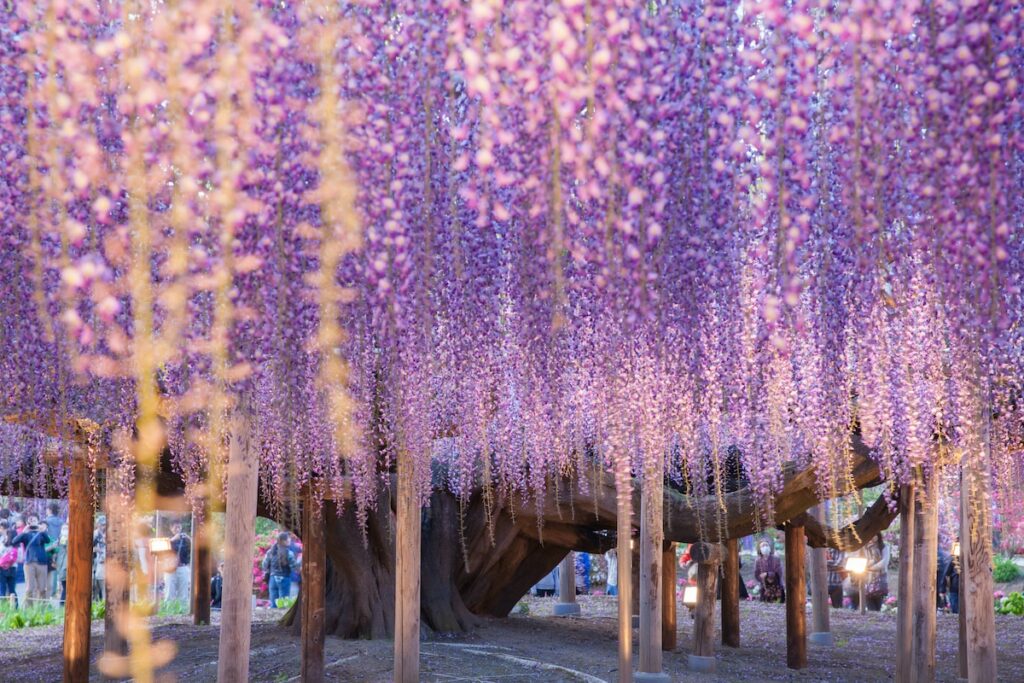
A Wisteria carries deep symbolism and meaning across various cultures. Here’s what a Wisteria symbolizes:
- Romance: In many cultures where the plant is native, including Korea, Wisterias symbolize romance.
- Playfulness and Adventure: The hanging blooms of the Wisteria are said to symbolize playfulness and adventure.
- Spirituality, Purity, and Innocence: White Wisteria flowers are often viewed as a symbol of spirituality, purity, and innocence.
- Sadness: Because of its falling shape – resembling the “crying willow,” wisteria also symbolizes sorrow.
- Purity and Truth: Like any white flower of beauty and grace, white wisterias represent purity and truth.
- Warning of Clinging Love: The symbolism of wisteria in certain ages dealt with a warning of clinging love and understanding that love is the fruit, but our obsession with it will be as choking as the plant itself.
- Good Luck and Fortune: In many cultures, the wisteria flower is considered to be a symbol of good luck and fortune. In Feng Shui, the plant is seen as a potent tool for attracting prosperity.
- New Beginnings: The wisteria blossoms symbolize new beginnings and the fleeting nature of all things.
Top 10 Reasons Why You Should Plant and Grow a Wisteria
- Stunning Blooms: Wisteria is renowned for its beautiful cascading blooms that come in shades of purple, pink, and white. These blossoms are not just visually stunning but also emit a sweet, pleasant fragrance that can fill your garden.
- Fast Growth: Wisteria is a fast-growing plant, which makes it a great choice if you want to quickly add some greenery and color to your outdoor space.
- Versatility: Wisteria can be trained as a vine, a tree, or even a shrub, making it a versatile addition to your garden. It can be used to decorate walls, fences, pergolas, or even grown as a freestanding tree.
- Attracts Wildlife: If you love nature and wildlife, wisteria is a great choice. Its fragrant flowers attract a variety of pollinators, including bees and butterflies, contributing to a vibrant and healthy ecosystem in your garden.
- Seasonal Interest: Wisteria provides interest throughout the seasons. In spring and summer, it’s covered with abundant flowers. In fall, its leaves turn a beautiful yellow before dropping, revealing the plant’s interesting branch structure in winter.
- Tolerant Plant: Wisteria is relatively hardy and tolerant. It can thrive in a variety of soils, and once established, it can tolerate periods of drought.
- Easy to Propagate: If you want more wisteria plants in your garden, you’re in luck. Wisteria is relatively easy to propagate from cuttings, layering, or even from seeds.
- Long Lifespan: With proper care, wisteria can live for several decades, or even up to a century. This means that planting a wisteria could provide beauty for generations to come.
- Symbolism: Wisteria carries deep symbolism in various cultures, representing things like romance, good luck, and new beginnings. Having it in your garden can add a layer of meaning to your space.
- Improves Mental Well-being: Like other forms of gardening, growing and caring for wisteria can be a therapeutic activity. It can help reduce stress, improve mood, and promote a sense of accomplishment.
5 Key Points to Consider When Choosing the Right Type of Wisteria
Choosing the right type of Wisteria for your garden depends on factors such as your climate, the space available, and your preference for flower color and form.
Here are some key points to consider:
- Species: There are about ten species of Wisteria, but the most popular ones are Wisteria sinensis (Chinese Wisteria) and Wisteria floribunda (Japanese Wisteria). Both species are known for their vigorous growth and stunning, fragrant flowers.
- Wisteria sinensis (Chinese): This is the species most commonly grown in home gardens. It’s a robust and fast-growing vine that produces large, drooping clusters of purple or white flowers in late spring, before the leaves appear. It also tends to bloom at a younger age than other species. The vine twines counterclockwise and can grow up to 60 feet tall.
- Wisteria floribunda (Japanese): This species is known for its long, graceful flower clusters that can reach up to 20 inches in length. The flowers open gradually from the top of the cluster to the bottom, prolonging the bloom time. It has a clockwise twining habit. Japanese Wisteria offers more color variations, including white, pink, and dark purple.
- Cultivars: Within these species, there are several cultivars that offer different flower colors and forms. For example, Wisteria sinensis ‘Alba’ has pure white flowers, while ‘Prolific’ is known for its abundant blue-violet flowers. Wisteria floribunda ‘Rosea’ has soft pink flowers, while ‘Royal Purple’ has dark purple blooms.
- Size and Growth Habit: Wisteria can be a sizable plant, so it’s important to choose a type that fits the space you have available. Some cultivars have a more compact growth habit, making them suitable for smaller gardens. Wisteria can also be trained to grow as a tree or shrub, but this requires regular pruning and training.
- Climate: While Wisteria is quite hardy, some types do better in certain climates. Both Chinese and Japanese Wisteria are suitable for USDA zones 5-9, but Chinese Wisteria tends to be more cold-hardy.
- Bloom Time: Most Wisteria blooms in late spring to early summer, but there can be some variation depending on the type. If you want to prolong the flowering season in your garden, consider planting different types of Wisteria that bloom at slightly different times.
What is the Difference Between Chinese and Japanese Wisteria?
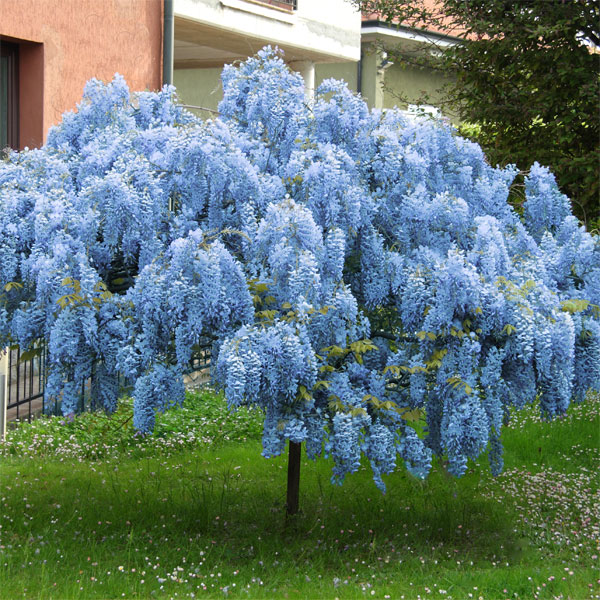
Chinese Wisteria (Wisteria sinensis) and Japanese Wisteria (Wisteria floribunda) are both popular species of Wisteria, but there are several differences between them:
- Growth Direction: Chinese Wisteria vines grow in a counter-clockwise direction, while Japanese Wisteria vines grow in a clockwise direction.
- Seed Pods: Both Chinese and Japanese Wisteria have fuzzy seed pods, distinguishing them from the smooth seed pods of American Wisteria (Wisteria frutescens).
- Growth Habits: Chinese Wisteria tends to be more aggressive and faster-growing than Japanese Wisteria.
- Leaf Structure: Japanese Wisteria typically has more leaflets per leaf (13-19), which can help distinguish it from Chinese Wisteria.
- Invasiveness: Both species have become invasive in parts of the United States, particularly on the East Coast and in the Southeast.
- Flowering: Both species produce fragrant clusters of flowers during May and June, but the flower clusters of Japanese Wisteria are often longer than those of Chinese Wisteria.
Note: despite their beauty, both Chinese and Japanese Wisteria can be invasive and need to be managed carefully to prevent them from overtaking native plants and ecosystems.
Is Wisteria Invasive? How to Manage
Yes, certain types of Wisteria, particularly the Chinese (Wisteria sinensis) and Japanese varieties (Wisteria floribunda), can be invasive. These species grow rapidly, often covering plants and structures in their path, which can lead to significant ecological damage.
Wisteria’s invasive nature is due to its robust growth and climbing abilities. It can climb over existing vegetation, even toppling large trees, thereby creating canopy gaps that favor further infestations. Over time, wisteria can shade and girdle native plants, leading to their decline.
However, this doesn’t mean you should completely avoid planting Wisteria. Proper management and care can prevent Wisteria from becoming invasive.
Here are 5 tips on how to manage Wisteria:
- Regular Pruning: Pruning twice a year – once in late winter and once in summer, can help control Wisteria’s growth and prevent it from invading other plants’ spaces.
- Plant Native Species: If you’re in the U.S., consider planting American Wisteria (Wisteria frutescens) instead of the Chinese or Japanese varieties. It’s less aggressive and just as beautiful.
- Monitor Growth: Keep a close eye on your Wisteria plant. If it starts to grow beyond its designated area, take immediate action to curtail its spread.
- Proper Support: Provide strong and suitable support for the Wisteria to grow on. This can help contain the plant and prevent it from spreading uncontrollably.
- Responsible Disposal: If you need to remove Wisteria, make sure to dispose of it responsibly to prevent it from spreading to new areas.
Note: While wisteria is a beautiful addition to any garden, it’s important to manage it responsibly to prevent it from becoming an environmental problem.
Where do Wisteria grow best?
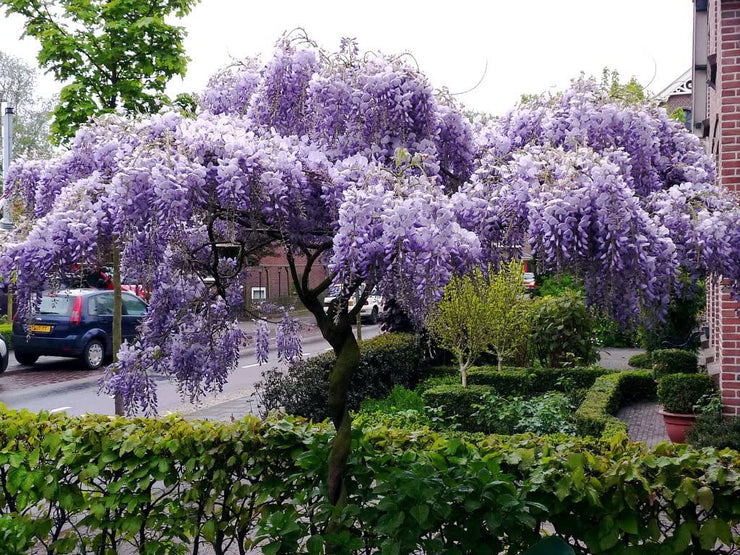
A Wisteria grows best in locations that receive at least six hours of direct sunlight daily. This ample sunshine encourages good flower development and vigorous growth. While they can tolerate partial shade, full sun is optimal.
They thrive in fertile, moist, but well-draining soil. If the soil is in poor condition, adding compost can improve its quality. However, Wisteria is adaptable and can grow in most types of soil.
When selecting a planting site, consider that Wisteria is a vigorous climber. Growing them against a sturdy wall or on a strong trellis can help manage their growth and display their stunning flowers. A south- or west-facing direction is ideal for this purpose.
In terms of climate, Wisteria performs well in full sun when grown in the North. However, in the South, particularly in zone 8, it benefits from afternoon shade to protect it from intense heat.
Lastly, while Wisteria can be grown in pots and containers, it’s not usually successful due to the plant’s high nutrient and water needs. They are better suited to garden settings where they have space to grow and access to ample nutrients.
How to Plant and Grow a Wisteria
Growing Wisteria involves several steps including site selection, planting, watering, fertilizing, pruning, and pest control.
Here’s a detailed step-by-step guide:
- Site Selection: Choose a location that gets at least six hours of sunlight each day. Wisteria also needs a lot of space to grow, so pick a location that can accommodate its size.
- Soil Preparation: Wisteria prefers fertile, well-drained soil. If necessary, improve your soil by adding organic matter like compost. The ideal soil pH is slightly acidic to neutral.
- Planting: Dig a hole that’s twice as wide and deep as the root ball of your plant. Place the wisteria in the hole, making sure the top of the root ball is level with the ground. Backfill the hole and firm the soil around the base of the plant.
- Watering: Water thoroughly after planting. Wisteria needs consistent moisture, especially during dry periods, but avoid waterlogging as this can lead to root rot.
- Fertilizing: Apply a balanced fertilizer in early spring to encourage growth and flowering. Avoid high-nitrogen fertilizers as these can promote leaf growth over blooms.
- Pruning: Wisteria requires regular pruning to control its size and promote flowering. Prune in late winter to remove dead wood and unwanted growth, and again in summer after flowering to keep the plant compact.
- Pest and Disease Control: Monitor regularly for pests like aphids and diseases such as powdery mildew. Use appropriate treatments as needed.
- Support: Provide a sturdy support structure like a trellis or arbor for the wisteria to climb. You can also train it to grow as a freestanding tree with the help of a sturdy stake.
- Winter Care: While wisteria is quite hardy, it may need some protection in colder climates. Consider mulching around the base of the plant to protect the roots from freezing temperatures.
A Comprehensive Guide to Caring for Wisteria
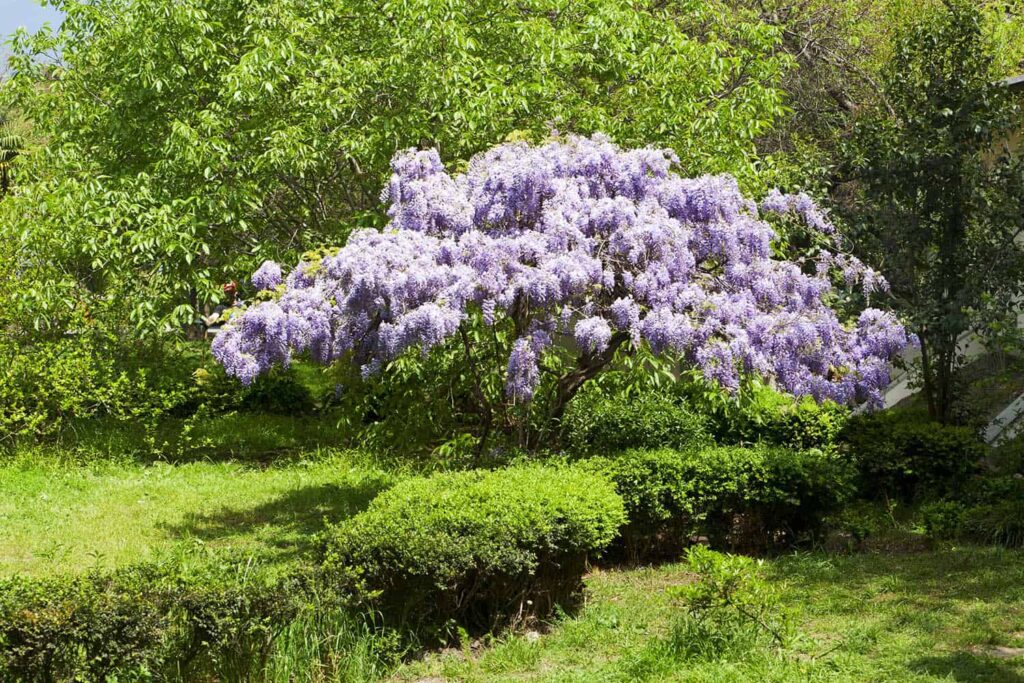
Wisteria trees are beautiful, fast-growing climbers known for their stunning, fragrant flower displays. However, they require a certain level of care and attention to thrive. Here’s a detailed guide on how to properly care for a Wisteria tree.
Choosing the Ideal Location
Wisteria trees thrive in locations with full sun exposure, at least six hours per day. They also need a sturdy support structure, like a wall or trellis, due to their vigorous growth habit. Choose a south- or west-facing direction if possible to maximize sunlight.
Planting Time and Equipment
The best time to plant Wisteria is in the early spring or late fall when the tree is dormant. You’ll need a spade for digging the hole, a sturdy trellis or similar support structure, and preferably some compost to enrich the soil if it’s not already well-draining and fertile.
Soil Type
Wisteria trees prefer fertile, well-draining soil. They can tolerate most soil types, but adding compost can improve poor-quality soil.
Watering Schedule for Wisteria
- Understand the Needs: Wisteria trees need regular watering, especially during dry periods. They prefer a deep watering that saturates the soil to the root level. However, they don’t like waterlogged soil, so it’s important to ensure good drainage.
- Establishment Phase: Newly planted Wisteria trees should be watered regularly to help them establish. Water deeply once a week, ensuring the soil is thoroughly saturated. This will encourage the roots to grow deep into the soil.
- Check Soil Moisture: Before watering established Wisteria, check the soil moisture level. You can do this by sticking your finger about an inch into the soil. If it feels dry at that depth, it’s time to water.
- Watering Method: Use a soaker hose or drip irrigation system to water at the base of the plant. This method reduces water evaporation and ensures the water gets to the root level where it’s needed most.
- Watering Frequency: During the growing season (spring and summer), you might need to water your Wisteria every 7-10 days, especially if there’s been little rainfall. However, in the dormant season (fall and winter), you can reduce watering to once every 2-3 weeks or even less if there’s sufficient rainfall.
- Adjust According to Weather: Adjust your watering schedule based on weather conditions. During hot, dry periods, your Wisteria may need more frequent watering. Conversely, during periods of heavy rainfall, you may not need to water at all.
- Monitor Plant Health: Keep an eye on your Wisteria tree’s health. Signs of overwatering include yellow leaves and soft, mushy stems. Signs of underwatering include wilting and brown, crispy leaves.
Important note: these are general guidelines. The exact watering schedule for your Wisteria may vary depending on factors like soil type, weather conditions, and the specific needs of your plant. Always monitor your plant’s health and adjust your care practices as needed.
A Step-by-step guide for Pruning Wisteria
- Choose the Right Time: The best time for heavy pruning of Wisteria is in late winter (February or March) when the plant is dormant and the leaves have fallen off. This allows you to see the structure of the plant clearly.
- Initial Pruning: If your Wisteria is overgrown, don’t be afraid to cut it back significantly. This won’t harm the plant and will help you regain control over its growth.
- Regular Pruning: Regular pruning twice a year is recommended to control the size of the plant and encourage more blooms. A summer pruning (July or August) should follow the initial late winter pruning.
- Pruning for Bloom Promotion: To promote flowering, prune back side shoots to the base pair of buds in late winter. This helps direct energy into flower production.
- Maintaining Structure: During winter pruning, also focus on maintaining the structure of the plant. Remove any branches that are growing away from your support structure or are not needed for shaping the plant.
- Deadheading: While not necessary for the health of the plant, removing spent flowers (deadheading) can improve the plant’s appearance and prevent the formation of seed pods, which can be a nuisance when they drop.
- Safety First: Ensure to use sharp and clean pruning tools to make clean cuts and reduce the risk of disease. Always wear protective gear, like gloves and safety glasses, while pruning.
Remember, pruning can be a little intimidating, especially with a fast-growing plant like Wisteria. But with patience and regular care, you can maintain a beautiful and healthy Wisteria tree in your garden.
Pest Control and Disease Management
- Identify the Problem: The first step in pest control and disease management is identifying the problem. Look for signs of damage such as wilting, discoloration, or unusual growth patterns. Some common pests and diseases that affect Wisteria include aphids, scale insects, leaf miners, powdery mildew, and crown gall.
- Regular Inspection: Regularly inspect your Wisteria plant for signs of pests and disease. Check the underside of leaves and near the soil line, where many pests tend to congregate.
- Pest Control: If you spot pests such as aphids or scale, consider using an insecticidal soap or horticultural oil. Apply according to the package instructions, ensuring to cover all plant surfaces. For severe infestations, a systemic insecticide could be considered.
- Disease Management: For fungal diseases like powdery mildew, remove infected parts of the plant and apply a fungicide. Ensure good air circulation around the plant to prevent future infections.
- Crown Gall Management: Crown gall is a bacterial disease that causes swollen galls on the plant’s stems or at the base. There’s no cure for this disease, so prevention is key. Avoid injuring the plant, as wounds can allow the bacteria to enter. Infected plants should be removed and destroyed to prevent the disease from spreading.
- Proper Pruning: Regular pruning can help manage both pests and diseases by removing infected parts and improving air circulation. Prune during the dormant season and avoid leaving stubs, which can serve as entry points for disease.
- Clean Gardening Practices: Keep the area around your Wisteria clean. Remove fallen leaves and other debris, which can harbor pests and disease-causing organisms. Sanitize your pruning tools regularly to prevent the spread of disease.
- Healthy Soil: Maintain healthy soil by adding compost or other organic matter. Healthy soil promotes a strong, disease-resistant plant.
- Professional Help: If you’re unsure about the problem or how to treat it, consider seeking help from a local extension service or professional arborist.
Reviving a Diseased Wisteria
If your Wisteria tree shows signs of disease, such as yellowing leaves or stunted growth, first identify the problem. Remove any infected parts of the tree and apply appropriate fungicides or pesticides if necessary. Ensure the tree is receiving adequate water and nutrients, but avoid overwatering as this can exacerbate some diseases.
While Wisteria trees do require some effort to maintain, their stunning blooms and vigorous growth make them a rewarding addition to many gardens.
Top 10 Interesting Facts About Wisteria
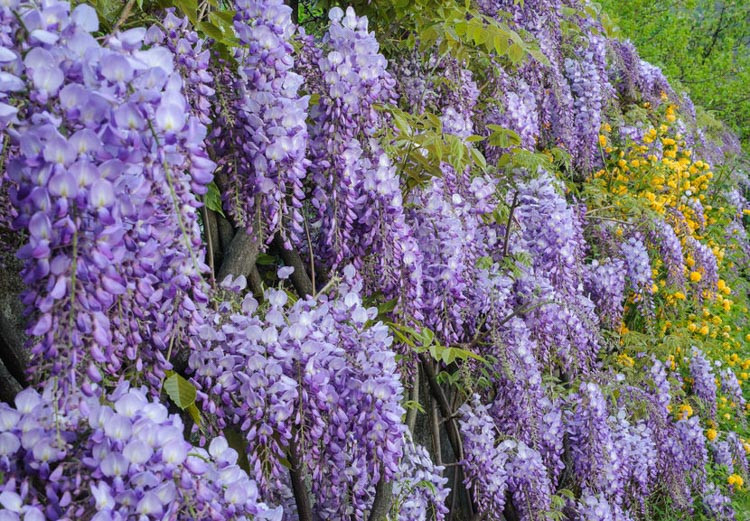
- Ancient Species: Wisteria is believed to be an ancient species of plant that dates back millions of years.
- Long Lifespan: With proper care and ideal conditions, Wisteria can live for over a hundred years. Some Wisteria vines in Japan are estimated to be over 1000 years old.
- Fast Grower: Wisteria is known to grow rapidly and can gain several feet in height and spread each year.
- Variety of Colors: The blooms of Wisteria come in a variety of colors, including shades of purple, pink, white, and even yellow.
- Edible Parts: Some parts of the Wisteria plant are edible. In Japan, Wisteria flowers are often used to make wine or added to salads.
- Highly Fragrant: Wisteria flowers are highly fragrant and are often used in creating perfumes.
- Versatile Plant: Wisteria can be trained into various forms such as trees, shrubs, or vines, making it a versatile addition to any garden.
- Poisonous Parts: Despite some parts being edible, other parts of the Wisteria plant, particularly the seeds and seedpods, are poisonous if ingested and can cause nausea, vomiting, stomach pain, and diarrhea.
- Symbolism: Wisteria carries deep symbolism in various cultures. It represents things like romance, good luck, new beginnings, and even serves as a warning of clinging love.
- Named After a Professor: The Wisteria plant was named after Dr. Caspar Wistar, a professor of Anatomy at the University of Pennsylvania. The ‘a’ at the end was added for euphony.
Where to Buy Wisteria?
- The Tree Center
- Wilson Bros Gardens
- TN Nursery
- Amazon
- Home Depot – Vine Plants
- Spring Hill Nurseries
- Tablelands Nurseries Online
Frequently Asked Questions
1. Is Wisteria a tree or bush?
Wisteria is technically neither a tree nor a bush, but a vigorous deciduous twining climber or vine native to China, Japan, and the eastern United States. This means it naturally grows by twisting around whatever support it can find, which can include trees, trellises, fences, and other structures.
However, with specific training and pruning, Wisteria can be grown in a form that resembles a small tree, commonly known as a standard. This practice involves staking the vine and pruning it to maintain a tree-like shape.
Despite often being referred to as Wisteria trees, it’s important to remember that this is a result of human intervention and not the plant’s natural growth habit. In its natural form, Wisteria is a vine.
2. How fast does Chinese Wisteria grow?
Chinese Wisteria, scientifically known as Wisteria sinensis, is a fast-growing vine. Depending on the variety and conditions, it can grow up to ten feet per year, and in some cases, it can even grow up to 25 feet per year. However, this rapid growth isn’t just in height – the plant also spreads wide, with mature plants reaching between 4 and 30 feet in width. Some sources suggest that Chinese Wisteria can grow vigorously up to 40 feet.
It’s important to note that while Chinese Wisteria grows quickly, it can take time for the plant to start producing flowers. In some cases, it can take between seven and twenty years before it reaches maturity and begins to blossom.
Additionally, the rate of growth can vary depending on factors like soil quality, sunlight, and watering schedule. For instance, young plants require heavy watering 2-3 times a week for the first 2-3 months, then regularly thereafter. Despite its vigorous growth, there are cultivars of Chinese Wisteria that grow more slowly, approximately 2 to 3 feet per year, making them a good choice for smaller gardens.
3. What does Wisteria smell like?
Wisteria is known for its intoxicating, sweet fragrance. The scent of Wisteria flowers is often described as similar to that of grapes or a sweet wine, which isn’t surprising given that the plant belongs to the legume family, Fabaceae, the same family as the grapevine. Some people also detect notes of honey or vanilla in the fragrance.
The strength and exact scent can vary slightly between different species and cultivars of Wisteria. For example, Chinese Wisteria (Wisteria sinensis) has a stronger scent than Japanese Wisteria (Wisteria floribunda), and some hybrid varieties have been bred specifically for their strong and appealing fragrance.
But no matter the variety, the scent of Wisteria is widely loved and is one of the reasons this plant is such a popular choice for gardens and landscapes. The fragrant flowers not only create an aromatic atmosphere but also attract bees, butterflies, and other pollinators.
Also read: